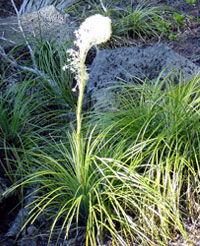Plant Data Sheet

Species (common
name, Latin name) – Beargrass,
Xerophyllum tenax
Range
– British Columbia east to
southwestern Alberta and south through the coast ranges and the west slope of
Sierra Nevada to central California.
Also in the Rocky Mountains.
States where beargrass is present:
CA, ID, MT, OR, WA, WY, AB, and BC.
Climate,
elevation – Beargrass often
occurs in cold, dry sites of the subalpine zone. There are low elevation populations of
beargrass, however, in which it occurs in bogs and some dry
areas.
Local occurrence
(where, how common) – Beargrass is relatively common in the
subalpine zone in the Cascades and Olympics.
Habitat
preferences – Beargrass
occurs on poor nutrient soils. It
is often a dominant understory on upper slopes under a canopy of conifers. In addition, it is common in subalpine
meadows in which there is full sunlight.
Plant strategy
type/successional stage (stress-tolerator, competitor, weedy/colonizer, seral,
late successional) – Beargrass is very frost tolerant. It is a facultative seral species that
does well following fire.
Associated species
– Huckleberry,
subalpine fir, mountain hemlock, Pacific silver fir, Shasta red fir, grand fir,
western white pine, western hemlock, and lodgepole pine.
May be collected
as: (seed, layered, divisions, etc.) – Seed.
Transplanting the whole plant is extremely
difficult.
Collection
restrictions or guidelines – Seeds start setting in July and continue
through September. Beargrass is
protected in many locations in which it exists (i.e. Olympics and
Cascades).
Seed germination
(needs dormancy breaking?) – seeds need at least 12-16 weeks of cold
stratification for germination.
Seed life (can be
stored, short shelf-life, long shelf-life) – Seeds can be dried and stored for extended
shelf life.
Recommended seed
storage conditions – Seeds
can be sown directly in the fall or stored dry at subfreezing temperatures.
Propagation recommendations
(plant seeds, vegetative parts, cuttings, etc.) – Plant
seeds in late fall and hand sow by covering seeds with ½” of soil.
Soil or medium
requirements (inoculum necessary?) – Well-drained
soil, gritty and open with good humus on top. No fertilizer products should be used.
For spring sowing, presoak the seed in distilled water for 24 hours, sow on
moist vermiculite with a light covering of more vermiculite, and cold stratify
for 16 weeks at 3 degrees C. Set
the flats in a growth chamber at 18 degrees C for 12 hours during the day and 13
degrees C for 12 hours at night. Seed also germinates well if it is soaked and
sown on a peat:vermiculite:perilite:pumice (2:2:2:1) edium, covered with 1-2 cm
of perlite, and wetted down.
Installation form
(form, potential for successful outcomes, cost) – Propagation is mostly done with seeds since
transplanting it is not effective.
Recommended
planting density – 3 oz. Of
seed per 1000 ft2
Care requirements
after installed (water weekly, water once etc.) – Do not water seeds a lot at first. They may
rot in the spring (late winter ) if they are too wet. Once they begin their seasonal growth,
they can handle a lot of water.
Normal rate of
growth or spread; lifespan – Beargrass reproduces by rhizomes, so once it
is established in an area, it is long-lived in that area unless area is heavily
disturbed.
Sources cited –
Nicholls, D. 2000. Beargrass, lily of the high country. Sandpoint Magazine. Keokee Co. Publishing, Inc: Summer.
Pojar, J. and A. MacKinnon. 1994. Plants of the Pacific Northwest Coast: Washington, Oregon, British Columbia and Alaska. B.C. Ministry of Forests and Lone Pine Publishing. Vancouver, British Columbia.
Rose, R.; C.E.C.
Chachulski; and D.L. Haase.
1998. Propagation of Pacific
Northwest
Native Plants. Oregon State
University Press. Corvallis,
Oregon.
Seed trust, Inc. 2002. Beargrass, Xerophyllum tenax seed packet. Native Wildflower Seeds.
USDA, FEIS 2002. www.fs.fed.us/database/feis/plants/forb/xerten/
Data compiled by (student name and date) – Daniela Shebitz, April 9, 2003